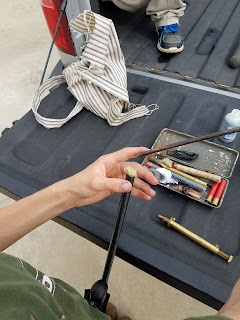The process of sighting in a gun or checking the zero on a gun can involve a lot of walking to and from the target to see where you hit... if you are using traditional paper targets.
Some of you probably
know that there is a company called Birchwood Casey that makes targets which,
when hit, expose a neon backing, showing the shooter where he or she has hit.
You may also know that these targets are expensive, and I don't know about you,
but I can't justify paying good money for a piece of paper I'm gonna fill full
of holes. So, I did a little research and found a way to make these targets
fairly inexpensively.
The article I found said to take a piece of neon card stock, cover it with clear packing tape and then coat it with a layer of black spray paint.
Well, apparently packing tape is a coveted item at my house, and I was only allowed 3 pieces, enough to cover most of a regular piece of printer paper. After securing the tape to the paper, I attached it to a piece of cardboard for rigidity. Next I took it outside and gave it a good coat of black spray paint.
The article I found said to take a piece of neon card stock, cover it with clear packing tape and then coat it with a layer of black spray paint.
Well, apparently packing tape is a coveted item at my house, and I was only allowed 3 pieces, enough to cover most of a regular piece of printer paper. After securing the tape to the paper, I attached it to a piece of cardboard for rigidity. Next I took it outside and gave it a good coat of black spray paint.
Once completed,
it was shot with a variety of calibers and performed well. My only mistake
was making the bull’s eyes the same color as the paper. If I were to hit the
bull’s eye, I would not be able to see it. Other than that, it worked to my expectations.
Because packing
tape was in short supply, I decided to attempt another version of the target,
but instead of tape, I used a clear sheet protector. In this instance, all I
had to do was slide a piece of paper into the sleeve and then paint it. This
version of the target was more finicky, and did not perform to the high
standards set by the previous attempt.
(Although, it
could still be used)
These targets
are somewhat reusable; a new coat of paint will freshen them up, but after a
while you can just get a new one. Oops, I mean MAKE a new one!
On another
note, since I talked about these targets being cheap, let’s look into that…
8” Birchwood
Casey “Shoot-N-C” targets are $15.50 for 30 of them at Walmart, or almost $.52 each. I
could buy a whole .357 shell for my revolver for that money! Okay, it’s not
THAT big of a deal, but check out the price for our target:
You can get 2
rolls of Scotch shipping tape (1.8” wide) for $8.97 at Walmart, paying 2.7
cents per foot, and using 4.6 feet to completely cover a piece of standard
blank paper. That equals out to… 12.42 cents per target.
But that’s just tape;
at Walmart, HP multi-purpose paper is 1.5 cents a sheet.
And then let’s say a 12oz can
of ColorPlace spray paint will cover 22 sq feet, which means it will cover 33 sheets of
paper, for 5 cents a sheet! Adding everything up we can make our targets for 18.92
cents each! On top of that you may already have many of the components
required, and what supplies you do buy, you can use for other purposes; unlike the shoot-N-C targets you get at walmart, which are good for only one purpose.
So, in conclusion, next time you see those Birchwood Casey targets on the rack at Walmart, remember this article and consider making them yourself!
-Have Fun Shootin'!
-Caleb





















